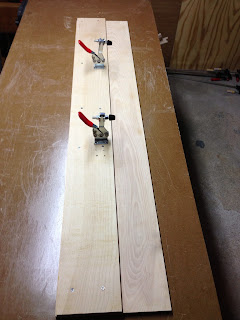I am dimensioning all the pieces pretty much the same way I did with the table. The pieces of birch I had set aside for the chairs have been flattened and thicknessed using the same planer sled method. This took two or three nights to accomplish. I have however used a different method for edge jointing this time. When building the table, I clamped the work piece to my bench and then used a clamping straight edge to guide my router equipped with a straight bit. This worked fine and I got flat, square edges. What I don't like about this method is the amount of time it takes to setup each pass and it will often take 2 - 3 passes per edge to make the entire edge flat and straight.
In this picture you can see the bow in the board, especially if you look at the right edge under the clamps. The strip to the left was taken in one pass, leaving a perfectly straight and square edge.
This jig was simple and inexpensive to make. I got some cheap, Chinese import toggle clamps from Amazon. They work fine, but the action on one of them is already muddy, though still functional. I learned while making this that gluing the two pieces of plywood together was absolutely necessary. While only using screws, the jig flexed too much and the toggle clamps would almost pull the top piece off of the bottom piece when clamped tight, probably too tight.
After jointing a dozen edges I think this will be my preferred jointer-less jointing method going forward. Of course, a jointer would make easy work of straightening and squaring edges, as would a jointer plane, but alas those tools do not yet exist in my shop. I'm happy to make due with this jointer jig for now. (Say jointer one more time). Jointer.
As for the work after jointing, I have ripped and cut just about all of the pieces needed to make the four chairs. The table saw sled I build and used when making the table made quick work of cutting down all those small pieces.
The back legs of the chairs will have angles cut in to them for the back of the chair as well as the bottom of the leg. The part of the leg that meets the seat won't be angled, making it easier to attach the apron. Cutting the angles will be done on the band saw and then cleaned up using a template and a router. I am thinking of making a simple router table for this. Probably not much more than a piece of MDF with a whole in it and my router mounted underneath. That process will be my next post on this subject.
Until then, thanks for reading!
Jim
PS - I have a new machine in my shop. Let me rephrase, I have an additional machine in my garage. It normally lives in the shed for most of the year, but snow forces me to move it to the garage for the winter. While it is visiting for the season, (and while not throwing snow) I'll put it to work as an extension cord administrator (analyst? liaison? electrical assistant?)







Looks good, Jim. Those'll be nice chairs.
ReplyDeleteThanks Dyami. I hope I finish them before my kids out grow them.
Delete